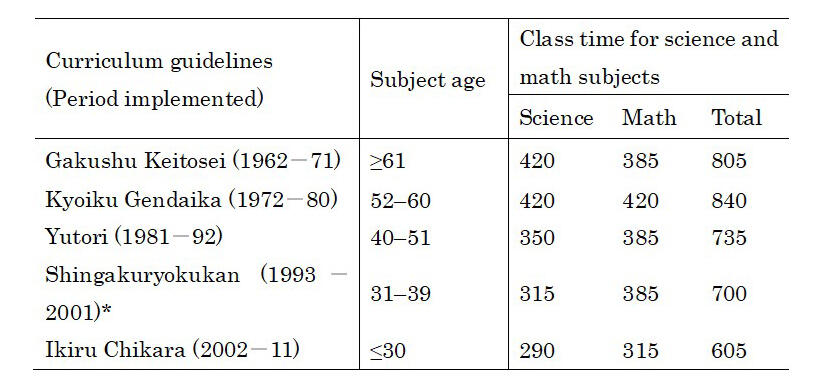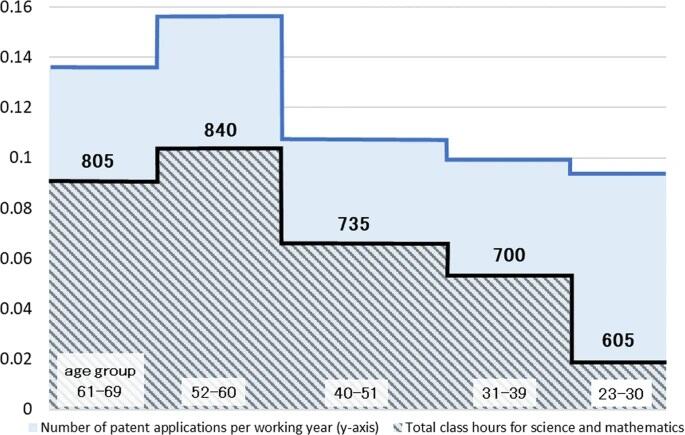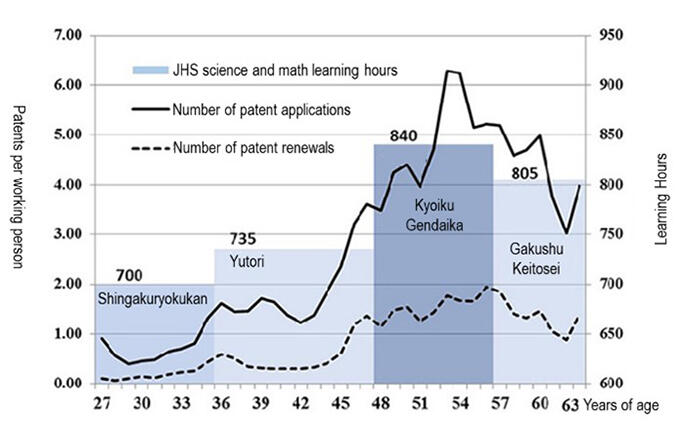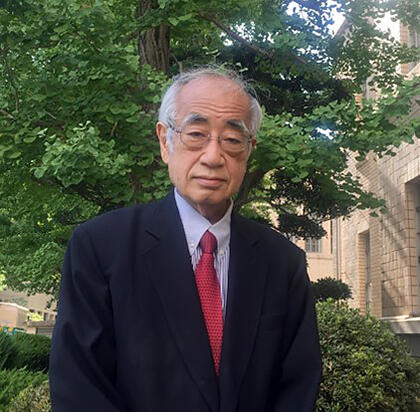A survey report has been published that explores how reduced class hours for science and math for junior high school students, implemented more than 40 years ago, have had a major effect on the decline of Japanese research capabilities. The outcomes of the survey showed that, with the three revisions of the Japanese government's curriculum guidelines from 1981 to 2002, the class hours for science and math subjects in junior high school were continually reduced. In these, the number of class hours cut over the three years of junior high school totaled 235 hours. The survey also indicated that, compared to the generation of students who attended junior high school before the reduction in hours, members of the generation who attended junior high school after the reduction in hours made significantly fewer patent applications. The generation who completed three years of junior high school during the period when the science and math class hours were continually reduced were aged 23-51 when the survey was carried out in 2020, and are equivalent to the majority of the Japanese working population.
Research Professor Kazuo Nishimura of the Center for Computational Social Science, Kobe University, who led the survey, said that he hopes that increasing the number of science and math hours in junior high schools, and changing the academic content in elementary and high school accordingly, will also raise Japan's research and development capabilities in the long term.
The effect of science and math class hours on patents
The survey report was published on July 1 with the title "Japan's R&D capabilities have been decimated by reduced class hours for science and math subjects" by Professor Nishimura with Professor Dai Miyamoto and Professor Tadashi Yagi of the Faculty of Economics, Doshisha University. Their paper was published in the international journal Humanities & Social Sciences Communications by Springer Nature. The group compared the results of an Internet survey of 5,000 subjects (people involved in research and development, employed either in engineering/technology or research) carried out in March 2020, and those of the same survey carried out in March 2016 (4,129 subjects). The aim of the surveys was to see the effects of the increased/decreased science and math hours in junior high schools resulting from the five revisions of the curriculum guidelines from 1962 (in date order: Gakushu Keitosei (Systemization of Learning), Kyoiku Gendaika (Modernization of Education), Yutori, Shingakuryokukan (New Vision for Academic Ability) and Ikiru Chikara (Zest for Life)) on the number of patent applications. The number of patent applications was used for the survey because it is seen as an indicator of research and development outcomes.
Table: Number of class hours for science and math education during junior high school by curriculum guideline

(Ref (Japanese only): National Institute for Education Policy Research curriculum guidelines database https://erid.nier.go.jp/files/COFS/h01j/index.htm)
Note: Subject age indicates the age in 2020 of subject groups who studied under their applicable curriculum guidelines for three years starting from their first year in junior high school.
Even if a patent is registered through an evaluation, if the renewal fee isn't subsequently paid and the renewal procedures are not carried out, the patent will expire. The surveys compared both the number of patent applications and the number of patent renewals for which the renewal procedures were carried out. The results clearly showed that, when compared to the preceding generations (aged 52 or more in 2020 when the survey was carried out), there was a major decrease in both the number of patent applications and the number of patent renewals by the generations who received science and math education with reduced class hours during their three years in junior high school due to the three curriculum guideline revisions known as Yutori, Shingakuryokukan and Ikiru Chikara (aged 23-51 in 2020 when the survey was carried out).
Junior high school students (aged 52-60 in 2020 when the survey was carried out) who studied under the curriculum guidelines known as Kyoiku Gendaika between 1972 and 1980, before these three curriculum guideline revisions, received a total of 840 class hours of science and math over the three years. They had 35 more class hours for science and math than the generation immediately before them (aged 61 or older in 2020 when the survey was carried out), who studied under the Gakushu Keitosei curriculum guidelines. When researchers compared the number of patent applications per person working in research and development for these two generations, they found that this increased from 0.135 to 0.156, corresponding to the increase in class hours.
On the other hand, the junior high school students who studied under the Yutori curriculum guidelines implemented in 1981 (aged 40-51 in 2020 when the survey was carried out) received 105 science and math class hours less than the preceding Kyoiku Gendaika generation, with 735 hours in total. The number of patent applications per person also dropped significantly, going from 0.156 in the Kyoiku Gendaika generation to 0.108. The science and math class hours decreased even more, and at the same time there was also a decrease in the number of patent applications per person. This same movement was seen among the junior high school students who studied under the Shingakuryokukan curriculum guidelines, implemented in 1993, and the Ikiru Chikara curriculum guidelines, implemented in 2002 (ages 31-39 and 23-30 respectively in 2020 when the survey was carried out).

Nishimura, K., Miyamoto, D. & Yagi, T. Japan's R&D capabilities have been decimated by reduced class hours for science and math subjects. Humanit Soc Sci Commun 9, 210 (2022). https://doi.org/10.1057/s41599-022-01234-0 (CC by 4.0)
A strong correlation with survey results from four years previously
So, what were the outcomes from the survey carried out by the same team in March 2016, four years previously? This had been completed by 4,129 subjects who worked in engineering/technology or research. The results showed that patent applications suddenly declined among the age group younger than 43.5 years old as of 2016. The survey data from 2020 indicated that the sudden decline in patent applications occurred in the age group who were younger than around 47 as of 2020. In other words, if the graph of the 2016 survey results was moved four years to the right, it would overlap almost entirely with the 2020 survey graph. The correlation between the two graphs is extremely strong: 0.923 as measured with a correlation function. With this, these two surveys carried out four years apart have made it even more obvious that the number of patent applications from the generation that received Yutori education, whose class time for science and math subjects was reduced across their three years of junior high school, significantly decreased compared to the previous generations. The research team concluded: "We understand that the two numerical movements caused by the changes in curriculum guidelines were consistent, and there is a strong correlation between research outcomes and class hours."
Junior high school science and math class hours and changes in patent applications (2016 survey)

Measures against the decline in research capabilities centered on universities
In recent years, a variety of data has made it clear that Japanese research capabilities are declining. Even the number of highly cited papers (papers that are cited numerous times by other researchers), which is emphasized as an evaluation indicator when comparing research capabilities, has continued to drop in recent years in Japan. According to a report published in August last year by the Ministry of Education, Culture, Sports, Science and Technology (MEXT)'s National Institute Of Science & Technology Policy (NISTEP), a comparison of the top 10% of highly cited papers based on the number of citations in each research field by country/region showed that Japan had dropped to 10th place, one position lower than the previous year (at the top, China overtook the United States for the first time). Looking at the Highly Cited Researchers list published every year by Clarivate, an international academic information service company, in the last few years, Japan has not reached the top 10 when the number of researchers is compared by country/region.
With regard to the number of patent applications, according to the World Intellectual Property Organization (WIPO), the number of international patent applications from Japan in 2021 was 50,260, down 0.6% from the previous year. Although Japan maintained its position as third in the world, it stood out among other high-ranking nations, whose patent applications increased compared to the previous year: China, which took the top spot for the first time in 2019, had 69,540 applications (up 0.9% from the previous year), the United States was second with 59,570 (up 1.9%), and Korea was in fourth with 20,678 (up 3.2%). Looking at the world as a whole, there were an estimated 277,500 applications, a 0.9% increase from the previous year, regardless of the effects of COVID-19.
Meanwhile, the majority of the measures that have been proposed and/or implemented against reduced research capabilities are those associated with research support for universities and national research institutes, and support for young researchers. The Sixth Science, Technology, and Innovation Basic Plan, which sets out the fundamental policy for science and technology measures between FY2021 and FY2025, also considers the strengthening of research capabilities to be one of its pillars. Measures that focus on universities, such as forming diverse individualistic university groups and establishing a university fund of 10 trillion yen, stand out.
There is also a strong sense of crisis regarding the decline of research capabilities felt by the Engineering Academy of Japan, an organization independent of the government whose membership consists of engineers and people with a keen interest in science and technology. It announced emergency proposals "to hold back the decline of Japan's engineering and science and technology capabilities" twice, in 2017 and 2019, and handed these over to the Minister of Education, Culture, Sports, Science and Technology. The strengthening of research capabilities was also the mainstay of these proposals. They called for the diversification of university research funding, the enrichment of graduate school doctoral courses, and the strengthening of industry-academia collaboration.
Alarm bells for education at high-school level and below
Professor Nishimura Kazuo has felt a strong sense of impending crisis concerning the decline in Japan's research capabilities since his time as a professor at Kyoto Institute of Economic Research. He identified the idea of a decline in university students' academic abilities, and that the cause lay in education at high-school level and below, early on, and his alarm bells are continuing to ring based on the results of a variety of research investigations.
Students Who Don't Understand Fractions, published in 1999 by Professor Nishimura as an author and editor, clarified the results of surveys showing that there were a considerable number of students in the humanities departments of top private universities who couldn't carry out elementary-school level arithmetic. The researchers involved surveyed students studying the humanities, and the aim was to inform people of the current situation: that the separation of young people from science and technology, which was already happening, was inviting a decline in academic abilities in all university students. Since the Common First-Stage Exam for national universities started in 1979, there had been an increase in the number of students who aspired to apply only to private universities from the start, without applying to national universities, dropped math and science (which were not exam subjects) after first-year high school level, and did not study them thereafter. This was a survey and document published from the perspective of a strong sense of crisis toward these circumstances.

Professor Nishimura, who believes the issue lies in education at high-school level and below, continued his investigative research and his activities to stimulate a social response. Until the 1970s, there was an emphasis on science education, shown by the fact that more than 90% of high school students finished their education in physics. However, Yutori education, which started with the revision of the curriculum guidelines in 1981, introduced a change that saw common compulsory subjects required only for first-year high school students, and second and third-year learning focused on optional subjects. A large drop in the science completion rate started to manifest. A survey that clearly showed the effects of this change on workplaces in the manufacturing industry was also one of Professor Nishimura's activities. The survey was carried out in December 2015 with the cooperation of nine companies in the manufacturing industry listed in the First Section of the Tokyo Stock Exchange. The survey subjects were young engineers in their 20s working in these companies who had graduated from graduate school doctoral courses, master's courses, faculties and technical colleges. In many cases, the survey outcomes showed that the rate of correct answers for 11 math, basic science and physics questions of a basic level learned in high school was a shocking 62.1 for math, 64.7 for basic science and 34.8 for physics.
On the other hand, in 2010 Professor Nishimura had published a joint paper indicating that people who had chosen math as an entrance exam subject in university exams had higher salaries compared to people who did not choose math. The people with the highest incomes were high-ranking people (a deviation score of at least 60) who studied science in university - all of these people aged 45-60 had a yearly income of over 10 million yen. The survey results showed that the people with the next-highest income were those with a highly ranked deviation score who had studied the humanities at university and sat university entrance exams in math.
Professor Nishimura has also focused on practical activities to change the status quo, rather than limiting himself to investigative research. Believing that it would be insufficient to merely change science and math education from high school onwards, he created a self-study textbook called Manabou! Sansu [Let's Study! Arithmetic] for elementary school students, which was published by a major publishing company, and in 2005 he started practical activities to ensure that elementary school students actually used it.
An increase in math and science class hours could lead to an increase in research and development capabilities
I asked Professor Nishimura how the results of these surveys, which once again confirm the effects of the reduced science and math class hours in junior high school, are being received.
-- Why are the class hours for science and math in junior high school the subjects of repeated surveys?
Professor Nishimura: The total hours of science and math in junior high school, on which we focused, are connected to revisions of the curriculum guidelines, so if we change the curriculum guidelines, the learning content of high schools (and elementary schools) will change, the entrance exam questions will change accordingly, and there will also be an effect on education after students have entered university. I believe that altering the total science and math class time in junior high school is representative of these changes.
-- What kind of response is needed in the future?
Professor Nishimura: There are expectations that when the class hours for math and science in junior high school increase, Japanese research and development capabilities will increase in the long term, if the learning content of elementary schools and high schools is also revised accordingly.
Editing Department Note: It is thought that there are a variety of factors behind the fall in Japan’s research capabilities, including a lack of support for doctoral students. The results of these surveys are introduced as the opinion of researchers on these causes.
KOIWAI Tadamichi, Science Reporter
Translated and edited by Science Japan



